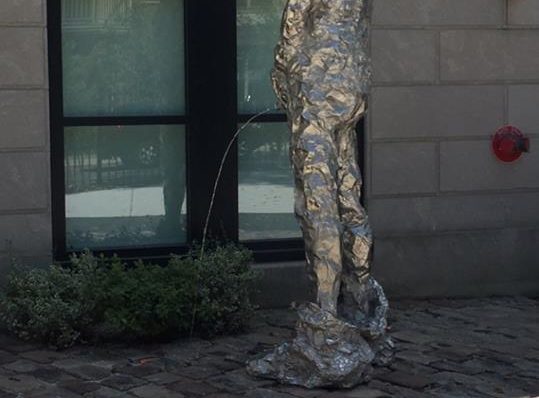Can I Use Your Restroom?

Can I Use Your Restroom?
A Look Into Columbus’s Potty Problem
by Jenny Bryant
Downtown Columbus generates a lot of foot traffic. From the Discovery District to the Short North, theatre, sports, restaurants, parks, bars, and live music create a vibrant and bustling atmosphere year-round. So where are the public bathrooms for all these people?
Spend an evening downtown and you’ll notice that the current options are quite lacking: a couple of super sketchy port-a-potties in Goodale Park, a pair of restrooms at the Columbus Commons that are only open during certain hours for roughly 5 months of the year, and bathrooms at the Scioto Mile that are completely closed from January-April.
The scarcity of downtown facilities negatively impacts a diverse range of people, from athletes and tourists to parents of small children (for whom the majority of bathroom trips are emergencies). The homeless residents of our city are particularly affected, too.
While some businesses have bathrooms, most are clearly marked as being for customers only. Sure, you can probably buy a latte at one of the area coffee shops during business hours in exchange for bathroom admittance, but those with little spending money are out of luck. Sneaking into a bar or restaurant is sometimes an option (shh), but you may end up getting kicked out.
Lisa Defendiefer, who works for the Capital Crossroads Special Improvement District, states, “SID staff recognize that people from all walks of life would benefit from access to public restrooms.” The lack of easily accessible public restrooms in the downtown area has led to complaints from businesses and residents alike. With limited options, some people even resort to finding the nearest building to pee on (which, by the way, is a misdemeanor in Ohio). Defendiefer says, “Our ambassadors are regularly cleaning areas downtown where people have urinated or defecated because no public restrooms are available.”
The city of Portland has seen some success on this issue with the installation of the Portland Loo, a permanently-installed public restroom model. City officials in Seattle, Austin, and Cincinnati have also installed Portland Loo models to provide accessible bathrooms for the public. The Portland Loo is specifically designed to discourage vandalism and loitering. These bathrooms are power-washed on a daily basis and even have hand-washing facilities outside. Defendiefer indicated that the Special Improvement District has looked into installing similar models in Columbus.
Donald Strasser, Columbus Coalition for the Homeless co-chair, has also spent some time pondering this issue. “The problem does not just affect homeless people,” says Strasser. The Columbus Coalition for the Homeless is currently working on two potential options to solve the restroom issue. The first is a stationary model similar to the Portland Loo, which Strasser feels would clearly benefit all people in the downtown area. The second is a mobile shower/toilet combo specifically designed for use by homeless people. Some local citizens and groups have expressed interest in the mobile model, and a GoFundMe campaign has been established in support of the cause. This model would target areas that already have homeless outreach programs, like Mount Carmel and Southeast Mental Health.
Seems like a clear-cut issue, right? However, Columbus Coalition for the Homeless and the Special Improvement District have both encountered several roadblocks. Initially, the Coalition considered locating stationary restrooms near the Statehouse, but the Republican-led legislature nixed the idea. Other proposed locations also proved unsuccessful as Strasser encountered a “not in my backyard” attitude. (In other words, while residents and businesses might recognize the need for better facilities, they don’t want anything installed near their properties.)
Generating the necessary capital is another issue. Defendiefer estimates that the models will cost between $38,000 — $100,000 per unit, depending on the design. “Unfortunately, we were unable to secure adequate funding, even for a pilot program.” Strasser, who has also sought funding for the stationary model with no success, concurs. “People are intrigued,” he says, “but no one has stepped up to the plate.” (If anyone is interested in collaborating, Strasser can be reached at strassed670146@gmail.com.) Ohio’s brutal cold-weather temps also complicate matters, as the toilets would have to be winterized during the harshest months.
City Councilman Michael Stinziano says, “The Council is very open to different ideas and to working with our citizens.” While he stated that the public restroom issue has not been brought to City Council before, the Council would be willing to evaluate options if enough resources are available. These options could include models similar to the Portland Loo or getting the Parks and Recreation department to expand the hours of operation for existing facilities.
The installation of better public restrooms would benefit everyone in the downtown area by providing adequate facilities for this most basic need. For now, though, downtown visitors will just have to continue to hold it.
BROUGHT TO YOU BY



